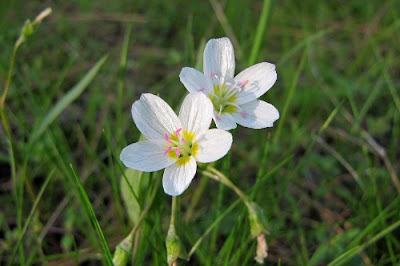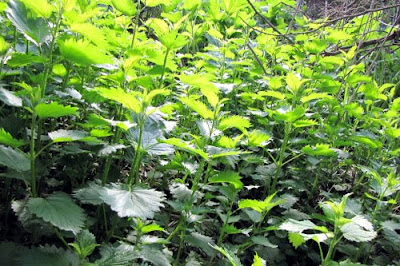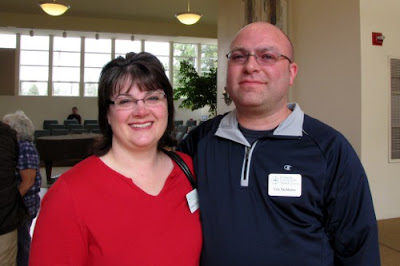Saturday, April 24, 2010
Native Plants


Last Friday, Anthony and I went to Wellpinit. During the drive, we passed a familiar stand of ponderosa pines, when I happened to notice a cluster of tiny white flowers growing on the forest floor. I'm not even sure how I saw them from my car, but they practically reached in and compelled me to stop. Once I took the time to observe them up close, I recognized them right away. Their scientific name is Claytonia lanceolata. Some people call them spring beauties, but I learned to know them as Indian potatoes, because of their edible, potato-like tubers. They represent one of the traditional foods I have only tasted on rare occasions.
I always assumed Indian potatoes were scarce or difficult to find because hardly anyone serves them anymore. But there they stood in great abundance all around me.
The human spirit is nourished as we become acquainted with the roots, flowers, and medicines growing in our midst. The landscape comes alive in unexpected ways, our knowledge expands, and our gratitude deepens. More important, our connection to nature assumes greater meaning in our lives. I looked at that plot of land for the last 39 years, and I only ever saw the trees, but then, like passing from darkness to morning light, the little meadow under the pine covering burst forth into brilliant colors. Those little flowers opened my heart, making me just little more awake and alive.



We also visited the serviceberries near Little Falls as the flower petals were just beginning to fall in preparation for the emerging fruit. I have a special affection for this particular tree because my auntie Thyra Moses brought me here several years ago when I was trying to learn to recognize this plant. I thought they might be hard to find, but once I saw them, the world opened and serviceberries spontaneously appeared all around me. It was like I had been sleeping and then awoke to find more beauty than I previously imagined.
The scientific name for serviceberries is Amelanchier canadensis.


These yellow flowers belong to the Oregon grape (Mahonia aquifolium), and they live in my back yard. We don't have to go far as we seek to deepen our appreciation for nature. We can learn the names, properties, and uses of plants growing in our own neighborhoods.
In our race to build ever-expanding housing developments and strip malls, I would ask people to pause long enough to see the beauty of our natural landscapes. Even on an individual level, I would encourage people to grow native plants in their homes and gardens. Native species reduce water consumption, increase natural diversity, and promote a deeper human connection to the land.
Thursday, April 22, 2010
Stinging Nettle

This afternoon I had an unusual opportunity to visit nature instead of going to work. Our department convened this morning for a thing called Program Development Day, meaning that we did not have our normal class schedule in the evening.
When I left the meeting, I felt tired and sick to my stomach. As many of you know, I'm preparing for gallbladder surgery on Monday, but the sun was shining and the plants were singing. I've been under so much stress lately that I just couldn't pass up my chance for a little nature therapy. I called my friend Adam and asked him to meet me for a plant-finding hike.


Adam suggested we visit a little spot along Hangman Creek where stinging nettle grows in abundance.
I've wanted to learn more about nettle ever since this plant cured my cold symptoms a few years ago. Nettle has some great medicinal properties and appears occasionally in the oral tradition of our Salish ancestors. I feel a kinship with the nettle plant and a calling to deepen my awareness of its character. By the way, this is a great way to observe Earth Day.

Adam was my hiking companion and plant guide.

Golden currants in full bloom.

A service berry tree blooms along the banks of Hangman Creek.

We followed the train tracks to get to Adam's nettle patch.

Hangman Creek.
Wednesday, April 21, 2010
Eleven
Today our family celebrated Whitney's 11th birthday. All the grandmas joined us for a family lunch and shared this special occasion. I can hardly believe how fast our baby is growing up! It seems just the other day we brought her home from the hospital, and now she's almost a young woman.
In these few short years, Whitney has grown to be a very thoughtful, caring, spiritually-minded person. She loves her family and shows great respect for all people. As her father, I feel very proud of the person she is becoming.
Tuesday, April 20, 2010
White

In the midst of my daily errands and personal anxiety, the trees came alive with beauty and white flowers. They interrupted the mental clutter and reminded me of a reality beyond distress. Cars passed all around me, filled with people rushing to work and talking on cell phones, while I stood alone by the roadside breathing in the simple communion. Did anyone else see the smiling faces on each flower petal? Did anyone else even notice the trees dressed in white?


Sunday, April 18, 2010
Roots

Only a few of us gathered roots this year. Those who stayed home must have had other things to do, or maybe they went out another day. I don't really know. But those who did gather made me happy. Their presence sheltered me from the loneliness seeping into edges of my mind.
For maybe an hour or more, I wandered the prairie alone with only the company of a song bird singing an odd melody, a horned lizard watching from a nearby stone, the sage brush bending in the wind, and of course the root people looking into my heart. For a maybe an hour, I lost myself in the timelessness of tradition and spirit and earth; the sky opened and my sadness lifted.
When the snow falls again and it comes time to set my table, the roots will remember how they lifted my heart. Maybe then they'll lift all of us again.
Sunday, April 11, 2010
Grandmothers Voices


Anthony came home today.
I picked him up at 8:00 in the morning and then drove straight to the Unitarian Universalist Church. I hadn't planned our reunion in quite this time, place, or manner, but several weeks ago my good friend Francesca asked me to sing for the grandmothers at an interfaith event to be held on this very day. They say Spirit moves in mysterious ways, always leading us through sacred "coincidences."
During the service, I told a brief story about my father. When I was a young man, we used to attend gatherings and dinners on reservations throughout the region. Without warning, my father often stood and announced to the people, "My son is going to sing for you now," or "My son is going to sing for the food." In those events, I had no way to prepare; I simply had to open my mouth and sing. This was one of my earliest forms of education as I learned to be in service to the people.
Francesca asked me to sing, and continuing the tradition of my father, I called upon my son to sing with me. I'm happy to say that he accepted the challenge. He stood beside me, opened his mouth, and sang the old ways.
The title of this blog reflects the purpose of the interfaith service. Some years ago, Franceca brought forth a vision of gathering indigenous women from around the world to share in a common wisdom and purpose. Since then, Francesca has traveled with the grandmothers to various places and countries, including Spokane.
Two of the grandmmothers spoke today: Vickie Downey of the Tesuqueh Pueblo and Eva Boyd of the Confederated Salish and Kootenai.

Eva read to the children of the congregation from a book in both Salish and English. It was very touching for me to hear those stories in our old language.

Francesca lit candles for the prayers of the people.

During the service, we sang a hymn titled, "Singer of Life." The song had a somewhat irregular, haunting quality, which reflected its Native American origin. In fact, the words were inspired by a Texcoco Nahuatl poem. I was moved to see the indigenous influence in their liturgy. So few churches include the cultural or spiritual traditions of other peoples and nations.
I was so moved by the hymn that Susan, the worship leader, gifted me with a copy of the Unitarian Universalist hymnal.

Eva spoke about the traditional foods of the Spokane people.

Vickie spoke of the ways her people have struggled to gain a voice within the United Nations.

Francesca, Eva, and Vickie.

As another divine "coincidence," I met two friends from high school at the service: Eric and Todd. Eric is pictured here with his wife Tammey. Todd played the flute for the service and somehow managed to escape my camera. Actually, Todd is the guy seated in the background of this picture.
Harris Hawk

This image is a still shot from a video I took at the Desert Museum, near Tucson. It shows just how close overhead the hawks flew during the flight demonstration. A few of us felt the brush of feathers as they passed. Harris hawks are unique because they hunt cooperatively in family groups, unlike other hawks that hunt alone.
Cactus Flowers


We've been home for about a week, but my mind continually reflects on the beautiful plants, flowers, and landscapes of Arizona in the spring.
On my last day in Arizona, Ron drove me to the airport, but not before stopping to see some of the neighborhood flowers. Linda had scouted them out during her morning jog and suggested that we pause to appreciate them. These plants were well worth the detour, especially the magnificent white cactus flower shown above. Does anyone know their names? It seems a shame that I remain so ignorant of something I admire so deeply.
Sunday, April 04, 2010
The Pascua Yaqui
We arrived just as the dancers were lining up in the courtyard by the church, each one awaiting a blessing. Some of the dancers wore long, black, purple-lined cloaks, along with black veils over their faces. Others wore a variety of masks, some comical, others grotesque. A young woman explained that the dancers represented the men who persecuted Jesus.
The Catholic symbolism was obvious, but the sound of deer toe rattles and Indian singing, along with the smell of smoke all combined to reveal something much older. It was a maginificent sight.
As much as I would have loved to share the sight with others, I was unable to take any pictures. A large sign stood in a prominant place above the courtyard advising visitors to refrain from using cell phones, recording devices, cameras, sketches, and alcohol. Out of respect for the Pascua Yaqui, I did not even bring a camera; I just felt lucky to witness even a small portion of this ceremony.
Desert Museum

Our family had the opportunity to visit the Arizona-Sonora Desert Museum near Tucson. What an amazing place! It was more of a living museum that highlights the plants and animals of the desert southwest.

A family of bobcats.

A nesting hummingbird.



Harris Hawks originated in Argentina and slowly made their way north. They arrived in Arizona about a hundred years ago and have adapted quite well.

A century plant.


Cactus flowers.

Agave plants.

I swear this lizard was following me back and forth along the glass.

This snake posed quite nicely.
Saturday, April 03, 2010
Grandma

We enjoyed a bitter-sweet visit with Rhonda's grandmother, who is now approaching her 94th year. She has always been such a positive influence in the family, but now she is beginning to show the effects of age. Her memories are beginning to fade, and yet even at this stage of her life, she continues to teach us through her example. I know so much more about aging and elderhood because of her, and that alone is a tremendous blesing.


The Apache Trail

As we left the ruins at Tonto National Monument, we returned to Gilbert by means of a long and winding road known as the Apache Trail. About a century ago, the US government enlisted members of the Apache tribes to build a supply road through the rugged desert mountains to the construction site of a new hydroelectric dam. The dam and reservoir would eventually bear the name of then-President Theodore Roosevelt, while the road would be named for the Apache.
The road has been improved somewhat in the last hundred years, but it still remains a dusty, 26-mile stretch of unpaved, but incredibly scenic highway.

Roosevelt Dam.

We encountered this western diamondback sunning himself on the highway.



The cacti were in bloom all around us. We must have stopped at least a half dozen times to photograph the plants and scenery.

An agave plant stands at the edge of a steep canyon. This photograph does not adequately show the extreme contrasts of the landscape. However, part of the Apache Trail is visible in the background.

Another reservoir formed by the dams along the Salt River.

At one point we stopped the car for me to get a picture of the Superstition Mountains. The sun was setting and casting a warm, reddish glow over the desert. I climbed a small hill away from the highway and paused. This saguaro captivated me by the way it towered over the desert and by the way the wind seemed to hiss as it passed through the cactus needles. I didn't want to leave. For a moment it was like all the mental chatter ceased as I felt myself merging into the beauty and mystery of that land.


The Superstition Mountains at sunset.


